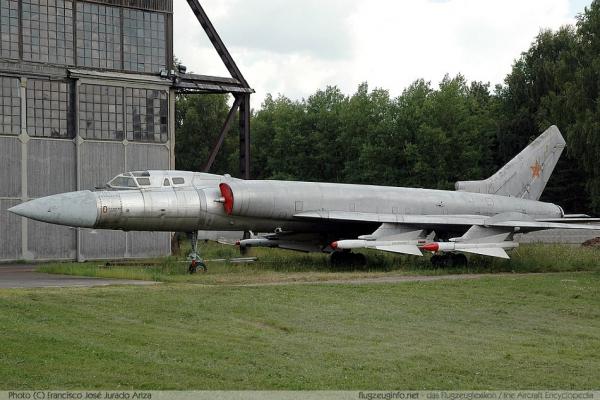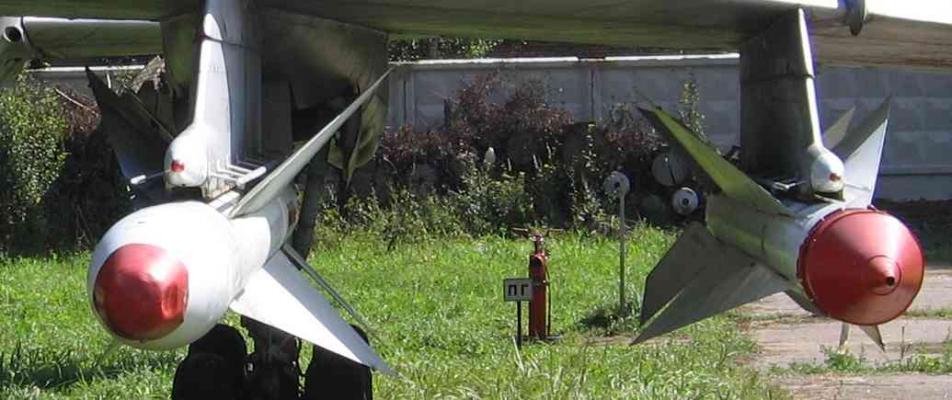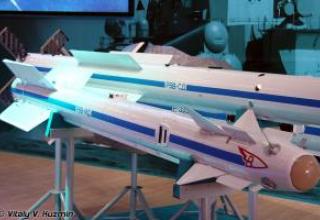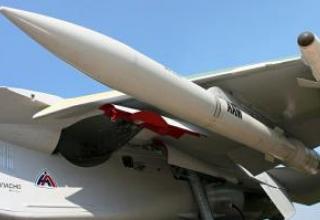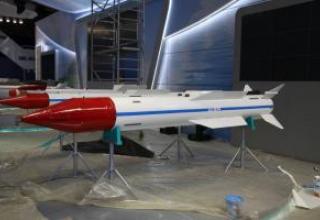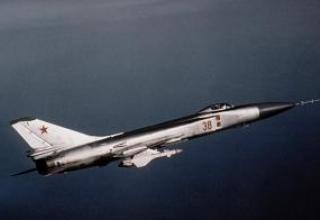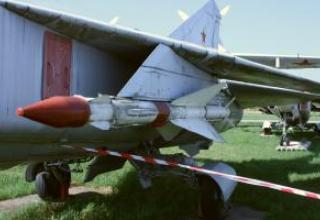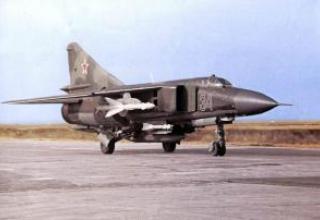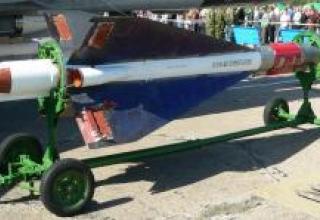In accordance with the Decree of the CPSU Central Committee and the USSR Council of Ministers N 608-293 of June 4, 1958 began the development of long-range aircraft and missile intercepting complex Tu-28-80 as the basis for the first stage of an echelonized defense system against flying on the shortest intercontinental route through the circumpolar areas of U.S. strategic bombers. To solve this problem, as well as to cover the perimeter of the northern borders of the USSR, it was required a long flight range and duration of the barrage.
Tupolev's heavy interceptor 128 was taken as the basis for the complex. (planned name in the series - Tu-28), which was a development of unclaimed front bomber "98". To fighters, this car could be attributed only with a high tension. Given the very limited maneuverability, one could not count on guaranteed timely turnaround with access to the rear hemisphere of the target. Therefore, from the very beginning of the work, for the first time in domestic practice, the requirement of all-roundness was imposed on missile weapons. However, taking into account the low sensitivity of infrared GSNs in the late 1950s in relation to the "thermal" version of the missile, this requirement was replaced by less stringent: it was necessary to ensure an attack in the rear hemisphere with a view to 3/4 in the horizontal plane. The modest value of the heavy interceptor ceiling determined the requirement to defeat targets flying with a significant excess in relation to the "128" aircraft.
Based on the specified long range of detection of the U-5B-80 radar, which was created under the leadership of Tikhomirov, up to 100 km (with the transition to auto tracking at 70 km) and a significant carrying capacity of the carrier, it was planned to develop a heavy missile equipped with a powerful BC with a launch range approximately twice as long as the already proven samples (K-7, K-8M, K-9).
The missile was to engage targets flying at altitudes of 5 to 23 km (including altitudes exceeding 5 to 6 km relative to the interceptor) with a speed of 800 to 1600 km/h (in the front hemisphere up to 2000 km/h), at ranges of up to 13 km from the rear hemisphere and 4 to 20 km from the front hemisphere with a volley of two missiles with a probability of 0.8-0.9.
The development of the semi-active radar SLN was assigned to Tikhomirov's team at the Design Bureau-339 and thermal SLN to Nikolaev at the Central Design Bureau-589. Presentation of the complex for factory tests was determined in the first quarter of 1961, for state tests - at the end of the same year. A year later, by the decree of July 4, 1959, the requirements for the complex were tightened in terms of target acquisition at speeds up to 1800-2200 km/h at altitudes up to 25-26 km. It was also proposed to increase the maximum range of missile launches to 60 km.
In the future, the managers of the creation of aircraft and missile equipment were replaced. Work on the radar, called "Smerch", headed by FF Volkov, on radar GSN - NA Viktorov in Research Institute-648, on thermal GSN - DM Khorol.
The first flight of the plane "128" took place in April 1961. After only 3 months, July 9, 1961, it flew over the field of the airfield Tushino, carrying two models of missiles under the wing. In the same year, the first autonomous launches of K-80 missiles were held - four from the ground and from the flying laboratory.
In 1962, launches were carried out both from a specially equipped flying laboratory Tu-104LK, and from three Tu-128. Along with four autonomous launches, nine launches of telemetry rockets with thermal and "radial" GSN on parachute targets PM-2, PM-4109 and VUM began firing thermal missiles at targets on the IL-28. At first, several launches failed due to the fault of the airborne radar. The first unmanned bomber was shot down on September 27, and by the end of the year two more such targets had been hit. Shooting at the IL-28 from the front hemisphere was worse: out of eight targets, 15 missiles were hit by only one. Only after finalization of the main "culprit" of failures - the radio detonator - it was possible to shoot down another IL-28 from the front hemisphere. The results of overflights of high-altitude versions of Yak-25 confirmed the possibility of firing targets flying with a significant excess. To facilitate the operation of missiles in the troops refined the design of wing attachment.
Beginning in April 1963, began testing the third prototype of the aircraft "128", first equipped with a full set of BREO, including the radar "Smerch", which made it possible to begin full-scale development of "radium" missiles. In the period from August 1963 to May 1965, the aircraft missile weapons were tested in conjunction with other elements of the complex during the second phase of state testing. The main targets in dozens of launches were still the same targets on the IL-28 base, fired from the front and rear hemispheres by missiles with both thermal and radar CNS, equipped first with radio detonators and then optical non-contact fuses. Two targets were also fired at the Yak-25PV flying at an altitude of 17500 m and exceeding 4500 m above the carrier. To study the process of targeting the interceptor with a target taken on auto-accompanying CNS missiles continued flying from different angles Tu-16, Su-9, MiG-19 and Yak-25RV. Taking into account the information received on the new American A-11 reconnaissance aircraft, the process of targeting high-altitude targets was simulated.
In 1965, during the launch of four telemetry and three combat missiles, three IL-28 drones were shot down. In addition, performed a couple of autonomous launches, 23 flights of the flying laboratory Tu-104LK. Based on the positive results of state tests, the complex was recommended for adoption in service and official put into mass production. The first aircraft "128", assembled at the serial plant number 64 in Voronezh, went into the air as early as May 13, 1961. From 1965 to 1966, serial production of missiles R-4 ("item 36") was carried out at the Kaliningrad plant number 455 (Kaliningrad mechanical plant), and later at the Kiev plant named after Artem.
In total, 23 targets were shot down during the tests, including five Yak-25RV, nine IL-28 and three Tu-16 targets. September 13, 1964 Chief Air Officer Vershinin approved the act of the State Commission.
Adoption for service was approved by a decree of April 30, 1965, giving the name of the complex Tu-128-80, the aircraft - Tu-128, radar - RP-28, and the rocket - R-4. In this case, for the missile was determined the maximum range of 20-25 km when shooting at targets flying at speeds up to 2000 km / h in the front hemisphere, and 10-12 km at a target speed of 1250 km / h - in the rear hemisphere. Targets were fired at altitudes between 8 and 21 km (including those flying in excess of 7-8 km). The suspension of the missiles lowered the maximum interceptor speed from 1910 to 1665 km/h, a value that determined the process of targeting.
After weaponization, launches continued to be conducted in order to eliminate identified shortcomings and enhance the missile's combat capabilities. In 1966, experimental launches were made against targets at low altitudes (500 m), but they failed due to failures and failures of onboard equipment. In 1967, work was carried out to reduce the lower boundary of the kill zone to 5 km, to eliminate the interference from the rocket engine from the "radius" CNS. In 1969 there were 12 launches of MiG-17, IL-28 and M-6 to test a modified fuse NOV-80M, the next year - to determine the causes of missiles divergence from the tracks. At the same time a couple of launches of R-4 on automatic drifting aerostats were made. In some years it was carried out up to fifty rocket launches.
During the development of the K-80 changed the tactics of the aircraft of the probable enemy, which moved to a breakthrough to the target at low altitudes. On this basis, the Decree of December 26, 1968 ¹ 1044-381 was given to develop an upgraded version of the complex, which was carried out by the beginning of the seventies. Tests in Vladimirovka were held from March 10, 1973 to July 24, 1974.
By the Order of the Minister of Defense No. 00104 of June 10, 1979, the upgraded Tu 128-80M complex with K-80M missile was adopted for service.
The foreign press also provides information on the development of a version of the missile with a passive radar CNS, designed to hit aircraft such as AVAKS and interference at ranges up to 40 km.
Composition:
The K-80 missile ("item 36") was designed according to the normal aerodynamic scheme (see projections).
The hull consisted of five compartments. The front compartment of the R-4R missile housed a semi-active homing radar head PARG-10VV (R-4MR - PARG-15VV). R-4T missile was equipped with a nitrogen-cooled thermal GSN T-80NM "Rubezh", which allowed the attack in the rear hemisphere of the target with a 3/4 angle in the horizontal plane. The R-4MT was equipped with the improved thermal GSN T-80NMD.
PARG-10BV used the conical scanning method to measure angular misalignment. The advantage of this method is simplicity of construction, but this method is not protected from amplitude interference, which can be easily combined for the purpose. With a scan frequency known to the enemy, the amplitude interference knocks the head out of tracking mode. Negative effects on the interference immunity of RGS were caused by the use of automatic gain control associated with the application of conical scanning. Random spread of scanning frequencies required the use of amplitude modulation of the interference spectrum. Naturally, the disturbance was reduced and there were no tracking disruptions, but the spans caused by the disturbance were unacceptably large. In order to increase the interference immunity, a random scanning frequency was introduced into the RGS from one copy to another. This was to force the adversary to widen the spectrum of the modulating signal and thus reduce the spectral density of the influence determining the span variance. In PARG-15VV RGS (P-4M missiles) cone scanning was organized by electronic switching of the beam position relative to the optical axis of the antenna by random law. Due to a very wide range of rapprochement velocities of the missile with a target (from 200 to 1600 m/sec) before starting the CNS was introduced into the hemisphere, indicating the attack of the target in the front or rear. The target was captured by the homing heads before launch when the missile was located on the launcher. The homing method is proportional approach.
In the second compartment were located: radio detonator RV-80 with the safety executive mechanism I-60-80 (on the rocket R-4T used an optical fuse NOV-80N), shrapnel and blast warhead weighing 53.6 kg, autopilot APR-80 and ampoule battery. The combat unit contained 29 kg of explosives and at detonation provided formation of 2400 fragments weighing 6g.
The third compartment accommodated a solid fuel engine PRD-84. It was equipped with a ballistic fuel charge RNDSI-5K weighing 121 kg, made in the form of a checker with a diameter of 0.288 m, length 1.269 m with a cylindrical channel diameter of 68 mm. The total thrust pulse in ground conditions was 24500 kgf. The P-4M missile was equipped with the modified PRD-84M engine.
In the tail of the rocket, around the elongated gas duct of the engine nozzle along the longitudinal axis of the rocket were numerous cylinders of pneumatic system, and behind them - steering machines drive the aerodynamic rudders.
The triangular wing had a considerable area and a large angle of sweep along the front edge (75°) with zero angle along the rear. Low load on the wing, combined with high energy-efficiency provided implementation of transverse overload of the missile to 21 units. All channels were controlled by differential deflection of the all-terrain rudders.
Missiles were suspended on rods to the launchers ACU-128, which had special rods, limiting the roll of missiles, preventing from "rubble" during the launch and impact on the pylon.
Characteristics:
| R-4 | R-4М | |
| Maximum target speed, km/h | 2000 | 2500 |
| Altitude range of the target, km | 8...21,5 | 0,5...21 |
| Maximum launch range, km PPP/ZPS | 20/13 | 25/13 |
| Minimum launch range, km ZPS | 3,0 | 2,2 |
| Overload of intercepted target, units | 2,0 | 2,5 |
| Maximum target exceedance, km | 5-6 | 7-8 |
| Weight, kg | 492 | 500 |
| Weight BC, kg | 53 | |
| Hull diameter, m | 0,315 | |
| Length, m | 5,36 | |
| The plumage scale, m | 1,5 | |
| Energy efficiency, kgc/kg | 50 | |
| Targeting the head: RGS - TGS - |
φ cu = ± 60° φ cu = ± 53° |
|
Testing:
From September 1 to November 28, 1945, the Nb.W.42 trophy mortar was tested at the Red Army State Automobile and Space Administration. The tests were carried out on the basis of the order of the Deputy Chief of SAKP, Major-General of the Engineering and Artillery Service of Serebryakov under the program of the range - SAKP task №4410.
In the report No 0116 dated 19.1.46 the description of the device and operation of the Wgr.42 mine, L.J.gr.Z23nA fuse and the mortar were given. Data on the heap and range, as well as theoretical calculations of internal and external ballistics are given. In addition, the report contains the results of analysis of the hull materials and equipment. The test manager was Captain Lerner.
The purpose of the tests was to determine:
- basic characteristics of the mortar and the mine Wgr.42 /description of the device, operation and purpose/.
- Intraballistic characteristics Wgr.42 /powder gas pressure and charge burn time/.
- aerodynamic characteristics Wgr.42 (wind tunnel blowing).
- The impact and maximum mine speed and the nature of mine buildup in the active area.
- Maximum range at 10°, 20°, 30° and 45° elevation angles.
- The mine's blast and fragmentation effect on the target.
- the system's strength, stability and rate of fire.
When measuring five minutes on centering belts, the projectile caliber was 214 mm, so the report suggested "counting the caliber not 210 mm as usual, but 214 mm".
The conclusions of report No. 0116 were as follows:
- The 210 mm Wgr.42 rocket projectile with the M-13UK missile was characterized by simplicity, cheapness and availability of materials that were used for its production. It was noted that the Germans considered it possible for missile chambers to allow deformation at maximum pressure beyond the elastic limits, i.e. the chambers were calculated not on the elastic limit, but on the temporary resistance to rupture with a margin of strength of the order n=1.5.
- Manufacturing of dinitroglycol powders for rocket charges had advantage in comparison with manufacturing of nitroglycerine powders. As glycol was based on cheap raw material base (vegetable oils), and glycerin was mainly produced from animal fats.
During the study of the mine, it was disassembled into structural elements. See their photos: photo 1, photo 2, photo 3, photo 4, photo 5, photo 6, photo 7.
From August 8th till August 13th 1945 at the State Mine Stockpile of Ukraine there were conducted shooting to determine experimental data for drawing up tables of shooting. Shots were fired at an elevation angle of 10°, 20°, 30° and 45° (maximum possible elevation angle).
The mortar was simultaneously loaded with 5 shells. The mortar was fired in single shots. The charge was corrected after each shot, and the shoot down rate was insignificant. Due to lack of German mortar sight, side aiming was made with MP-41 sight.
As a result of tests it was received:
- The puchiness and range of the 210 mm Wgr.42 missile did not differ from the characteristics of the domestic M-13UK projectile. When the angle of Ө decreases (elevation angle) the heap drops sharply especially in range: gri Ө=10° the range of 2650m and the WDX = 1/17 was obtained; WDX = 1/58, at Ө=45° the range of 8000 m and the WDX = 1/88; WDX = 1/76.
- The effect of the Wgr.42 mine on the target was undoubtedly more powerful than that of the M-13UK, as the 210mm projectile carried 9.27 kg of explosives, while the M-13UK carried 4.55 kg. However, the Wgr.42 has a smaller fill factor /WB to passive weight ratio than the M-13UK. The M-13UK had a filling ratio of 13% and Wgr.42 had a filling ratio of 10%.
- The design of the Wgr.42 mine was characterized by the simplicity, affordability and accessibility of the materials used in its manufacture.
- Calculation of internal ballistics showed the following results: at charge temperature - 40°C the pressure in the chamber was equal to 106 kg/cm2, at charge temperature +40°C the pressure was equal to 325 kg/cm2. This gave grounds to suppose that the rocket charge will work at low temperatures and will not break the chamber at high ones.
- The chemical composition and physical characteristics of the gunpowder rocket charge did not differ from glycol powders, which were adopted in German artillery. Powder strength and caloric value were of the same order as M-13UK rocket charges, but the use of glycol undoubtedly extended the raw material base of the powder production.
- The design of the 210-mm 5-barrel Nb.W.42 mortar carriage did not differ from that of the 150-mm 6-barrel Nb.W.41 mortar carriage.
- The maneuverability and ease of operation are satisfactory, but the power of the 210 mm mortar salvo is about 1.5 times smaller than that of the BM-13. For one salvo of 5-barrel mortar ejected 46 kg ВВ, and installation BM-13 - 73 kg ВВ.
It was concluded that the design of the 210 mm Nb.W.42 rocket launcher and its projectile was found to be successful, both in combat and operational terms.
The mortar was disassembled into its structural elements during its study. See their photographs: photo 1, photo 2, photo 3, photo 4, photo 5, photo 6, photo 7, photo 8.
Sources:
- Р.Ангельский, В.Коровин "Отечественные управляемые ракеты класса «Воздух-Воздух»/Авиация и Космонавтика №1 2003г./
- "Авиация ПВО России и научно-технический прогресс". 2005 г.
- М-Хобби. В.Марковский, К.Перов. Развитие советских авиационных ракет класса "воздух-воздух"
